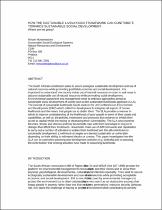 ResearchSpace
ResearchSpace
How the sustainable livelihoods framework can contribute towards sustainable social development: where are we going?
JavaScript is disabled for your browser. Some features of this site may not work without it.
- ResearchSpace
- →
- Research Publications/Outputs
- →
- Conference Publications
- →
- View Item
| dc.contributor.author |
Murambadoro, M

|
|
| dc.date.accessioned | 2010-10-07T11:54:14Z | |
| dc.date.available | 2010-10-07T11:54:14Z | |
| dc.date.issued | 2009-08 | |
| dc.identifier.citation | Murambadoro , M. 2009. How the sustainable livelihoods framework can contribute towards sustainable social development: where are we going?, IAIAsa 2009 National Conference, Wilderness, George, 23-26 August 2009, pp 5 | en |
| dc.identifier.uri | http://hdl.handle.net/10204/4454 | |
| dc.description | IAIAsa 2009 National Conference, Wilderness, George, 23-26 August 2009 | en |
| dc.description.abstract | The South African constitution seeks to secure ecological sustainable development and use of natural resources while promoting justifiable economic and social development. It is important to understand how society makes use of natural resources in order to seek ways to advance sustainable use of natural resources while promoting social development. Environmental assessment and management needs to embrace approaches aimed at sustainable social development of society such as the sustainable livelihoods approach (SLA). The concept of sustainable livelihoods has its roots in the UN Conference on Environment and Development (1987) which called for development to integrate all aspects of human livelihoods and the means that people use to obtain them. The SLA provides a manner in which to improve understanding of the livelihoods of poor people in terms of their assets and capabilities, as well as, the policies, institutions and processes that enhance or inhibit their access to capital whilst increasing or decreasing their vulnerability. The SLA also examines the risks, shocks and stresses and how households cope with them and adapt to long term changes that affect their livelihoods. Households make use of different assets and capabilities to carry out a number of activities to sustain their livelihood and this all contributes to sustainable development. Livelihoods strategies are deemed sustainable or vulnerable depending on their ability to withstand shocks or stresses. This paper investigates how the SLA can be used when planning new development activities (e.g. biofuels) and in assessing the contribution that existing activities have made to sustaining livelihoods. | en |
| dc.language.iso | en | en |
| dc.relation.ispartofseries | Conference Paper | en |
| dc.subject | Poverty | en |
| dc.subject | Sustainable social development | en |
| dc.subject | Sustainable livelihoods framework | en |
| dc.subject | IAIAsa 2009 National Conference | en |
| dc.title | How the sustainable livelihoods framework can contribute towards sustainable social development: where are we going? | en |
| dc.type | Conference Presentation | en |
| dc.identifier.apacitation | Murambadoro, M. (2009). How the sustainable livelihoods framework can contribute towards sustainable social development: where are we going?. http://hdl.handle.net/10204/4454 | en_ZA |
| dc.identifier.chicagocitation | Murambadoro, M. "How the sustainable livelihoods framework can contribute towards sustainable social development: where are we going?." (2009): http://hdl.handle.net/10204/4454 | en_ZA |
| dc.identifier.vancouvercitation | Murambadoro M, How the sustainable livelihoods framework can contribute towards sustainable social development: where are we going?; 2009. http://hdl.handle.net/10204/4454 . | en_ZA |
| dc.identifier.ris | TY - Conference Presentation AU - Murambadoro, M AB - The South African constitution seeks to secure ecological sustainable development and use of natural resources while promoting justifiable economic and social development. It is important to understand how society makes use of natural resources in order to seek ways to advance sustainable use of natural resources while promoting social development. Environmental assessment and management needs to embrace approaches aimed at sustainable social development of society such as the sustainable livelihoods approach (SLA). The concept of sustainable livelihoods has its roots in the UN Conference on Environment and Development (1987) which called for development to integrate all aspects of human livelihoods and the means that people use to obtain them. The SLA provides a manner in which to improve understanding of the livelihoods of poor people in terms of their assets and capabilities, as well as, the policies, institutions and processes that enhance or inhibit their access to capital whilst increasing or decreasing their vulnerability. The SLA also examines the risks, shocks and stresses and how households cope with them and adapt to long term changes that affect their livelihoods. Households make use of different assets and capabilities to carry out a number of activities to sustain their livelihood and this all contributes to sustainable development. Livelihoods strategies are deemed sustainable or vulnerable depending on their ability to withstand shocks or stresses. This paper investigates how the SLA can be used when planning new development activities (e.g. biofuels) and in assessing the contribution that existing activities have made to sustaining livelihoods. DA - 2009-08 DB - ResearchSpace DP - CSIR KW - Poverty KW - Sustainable social development KW - Sustainable livelihoods framework KW - IAIAsa 2009 National Conference LK - https://researchspace.csir.co.za PY - 2009 T1 - How the sustainable livelihoods framework can contribute towards sustainable social development: where are we going? TI - How the sustainable livelihoods framework can contribute towards sustainable social development: where are we going? UR - http://hdl.handle.net/10204/4454 ER - | en_ZA |





